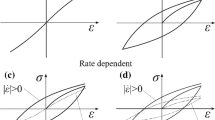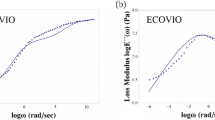Abstract
The dynamic properties of rubber-like materials are characterised by a significant dependence on the predeformation and the frequency. The focus of this paper is to represent the frequency and predeformation dependent dynamic behaviour of a carbon-black filled SBR rubber with 40 phr amount of filler using the concept of fractional derivatives. Thus, we introduce a constitutive approach of finite fractional viscoelasticity which is suitable to approximate the dynamic material properties with respect to the storage and the loss modulus. The constitutive approach is based on a proposal of [18] which was modified by a deformation dependent relaxation function in a previous work [46] to represent the dependence of the dynamic modulus on the predeformation and the frequency. The constitutive approach in [46] is based on the classical theory of finite viscoelasticity and formulated in the frequency domain. In this work, the approach of [46] will be extended by the concept of fractional derivatives and compared to the classical one. Thus, the classical and the extended fractional constitutive models are firstly introduced and the complex modulus tensors of both models are derived. It should be mentioned that both constitutive approaches are firstly formulated in the time domain. This formulation is necessary to satisfy the thermodynamical consistency. In order to conduct vibration analyses of elastomer structures with high computational efficiency, the equations are then transferred to the frequency domain. To this end, the constitutive model is geometrically linearised in the neighbourhood of a large and temporally constant predeformation. The incremental strain tensor varies harmonically and its amplitude has to be small. Furthermore, parameter identification of both approaches is done on the basis of quasi-static and dynamic investigations of the carbon-black filled SBR rubber. The numerical results of the parameter identification of the classical and the fractional model are compared to each other with respect to the number of necessary material parameters and the quality of the approximation. Finally, the numerical implementation of the frequency domain formulation into the finite element code MSC Marc on the basis of the proposal of [28] will be presented.













Similar content being viewed by others
References
Adolfsson K (2004) Nonlinear fractional order viscoelasticity at large strains. Nonlinear Dyn 38:233–246
Adolfsson K, Enelund M (2003) Fractional derivative viscoelasticity at large deformations. Nonlinear Dyn 33:301–321
Bagley RL, Torvik PJ (1979) A generalized derivative model for an elastomer damper. Shock Vib Bull 49:135–143
Bagley RL, Torvik PJ (1983) Fractional calculus—a different approach to the analysis of viscoelastically damped structures. AIAA J 21(5):741–748
Bagley RL, Torvik PJ (1983) A theoretical basis for the application of fractional calculus to viscoelasticity. J Rheol 27(3):201–210
Bagley RL, Torvik PJ (1985) Fractional calculus in the transient analysis of viscoelastically damped structures. AIAA J 23(6): 918–925
Bueche F (1961) Mullins effect and rubber-filler interaction. J Appl Polym Sci 5:271–281
Caputo M (1967) Linear models of dissipation whose Q is almost frequency independent II. Geogr J R Astron Soc 13(5): 529–539
Caputo M, Mainardi F (1971) Linear models of dissipation in anelastic solids. La Rivista del Nuovo Cimento 1:161–198
Drozdov AD (1997) Fractional differential models in finite viscoelasticity. Acta Mater 124:155–180
Enelund M, Josefson L (1997) Time-domain finite element analysis of viscoelastic structures with fractional derivatives constitutive relations. AIAA J 35(10):1630–1637
Enelund M, Maehler L, Runesson K, Josefson L (1999) Formulation and integration of the standard linear viscoelastic solid with fractional order rate laws. Int J Solids Struct 36:2417–2442
Gaul L, Schanz M (1994) Dynamics of viscoelastic solids treated by boundary element approaches in time domain. Eur J Mech A 13(4):43–59
Gaul L, Schanz M (1999) A comparative study of three boundary element approaches to calculate the transient response of viscoelastic solids with unbounded domains. Comput Method Appl Mech Eng 179:111–123
Greeve R (2003) Kontinuumsmechanik: E in Grundkurs für Ingenieure und Physiker. Springer, Berlin
Gurtin ME, Herrera I (1965) On dissipation inequalities and linear viscoelasticity. Q Appl Math 23(3):235–245
Haupt P (2000) Continuum mechanics and theory of materials. Springer, Berlin
Haupt P, Lion A (2002) On finite linear viscoelasticity of incompressible isotropic materials. Acta Mater 159:87–124
Haupt P, Lion A, Backhaus E (2000) On the dynamic behavior of polymers under finite strains: constitutive modelling and identification of parameters. Int J Solids Struct 37:3633–3646
Kari L (2001) On the waveguide modelling of dynamic stiffness of cylindrical vibration isolators, part I: the model, solution and experimental comparison. J Sound Vib 244(2):211–233
Kari L (2001) On the waveguide modelling of dynamic stiffness of cylindrical vibration isolators, part II: the dispersion relation solution, convergence analysis and comparison with simple models. J Sound Vib 244(2):235–257
Kilbas AA, Srivastava HM, Trujillo JJ (2006) North-Holland mathematics studies—theory and applications of fractional differential equations, vol 204. Elsevier, Amsterdam
Koeller RC (1984) Applications of fractional calculus to the theory of viscoelasticity. J Appl Mech 51:299–307
Lewandowski R, Chorazyczewski B (2010) Identification of the parameters of the kelvinuvoigt and the maxwell fractional models, used to modeling of viscoelastic dampers. Comput Struct 88 (1–2):1–17
Lewandowski R, Pawlak Z (2011) Dynamic analysis of frames with viscoelastic dampers modelled by rheological models with fractionalderivatives. J Sound Vib 330(5):923–936
Lion A (1997) On the thermodynamics of fractional damping elements. Continuum Mech Thermodyn 9:83–96
Lion A (2001) Thermomechanically consistent formulations of the standard linear solid using fractional derivatives. Arch Mech 53:253–273
Morman KN, Nagtegaal JC (1983) Finite element analysis of sinusoidal small-amplitude vibrations in deformed viscoelastic solids, part I: theoretical development. Int J Numer Meth Eng 19(7): 1079–1103
Mullins L (1948) Effect of stretching on the properties of rubber. Rubber Chem Technol 21(281):281–300
Mullins L (1969) Softening of rubber by deformation. Rubber Chem Technol 42:339–362
Nonnenbacher TF (1991) Fractional relaxation equations for viscoelasticity and related phenomena. Rheol Model 381: 309–320
Oldham KB, Spanier J (1974) Mathematics in science and engineering—the fractional calculus: theory and applications of differentiation and integration to arbitrary order, vol 111. Academic Press, London
Payne AR (1962) The dynamic properties of carbon black-loaded natural rubber vulcanizates: part I. J Appl Polym Sci 6(19):57–63
Payne AR (1962) The dynamic properties of carbon black-loaded natural rubber vulcanizates: part II. J Appl Polym Sci 6(21): 368–372
Podlubny I (1999) Mathematics in science and engineering—fractional differential equations: an introduction to fractional derivatives, fractional differential equations, to methods of their solution and some of their applications, vol 198. Academic Press, London
Reese S, Govindjee S (1998) A theory of finite viscoelasticity and numerical aspects. Int J Solids Struct 35(26–27):3455–3482
Retka J (2011) Vibroakustisches Verhalten von viskoelastischen Strukturen unter finiter Vordeformation. Fakultät für Luft- und Raumfahrttechnik, Institut für Mechanik der Universität der Bundeswehr München, Dissertation
Schiessel H, Metzler R, Blumen A, Nonnenbacher TF (1995) Generalized viscoelastic models: their fractional equations with solutions. J Phys A 28:6567–6584
Schmidt A (2003) Finite-Elemente-Formulierungen viskoelastischer Stoffgesetze mit fraktionalen Zeitableitungen. Institut A für Mechanik der Universität Stuttgart, Dissertation
Schmidt A, Gaul L (2006) On a critique of a numerical scheme for the calculation of fractionally damped dynamical systems. Mech Res Commun 33(1):99–107
Schwarz HR (1988) Finite element methods. Academic Press, London
Schwarzl FR, Zahradnik F (1980) The time temperature position of the glass-rubber transition of amorphous polymers and the free volume. Rheol Acta 19:137–152
Simo JC (1987) On a fully three-dimensional finite-strain viscoelastic damage model: formulation and computational aspects. Comp Meth Appl Mech Eng 60:153–173
Slonimsky GL (1967) Laws of mechanical relaxation processes in polymers. J Polym Sci Part C 16:1667–1672
Williams M, Landel R, Ferry JD (1955) he temperature dependence of relaxation mechanisms in amorphous polymers and other glass-forming liquids. University of Wisconsin Department of Chemistry, Madison, pp 3701–3707
Wollscheid D, Lion A (2013) Predeformation and frequency-dependent material behaviour of filler-reinforced rubber: experiments, constitutive modelling and parameter identification. Int J Solids Struct 50(9):1217–1225
Zienkiewicz O (2005) The finite element method: its basis and fundamentals, 6th edn. Elsevier, Butterworth
Acknowledgments
The authors would like to thank the Deutsche Forschungsgesellschaft for financing this project and the Freudenberg Forschungsdienste KG in Weinheim for providing the filled rubber compound.
Author information
Authors and Affiliations
Corresponding author
Rights and permissions
About this article
Cite this article
Wollscheid, D., Lion, A. The benefit of fractional derivatives in modelling the dynamics of filler-reinforced rubber under large strains: a comparison with the Maxwell-element approach. Comput Mech 53, 1015–1031 (2014). https://doi.org/10.1007/s00466-013-0946-4
Received:
Accepted:
Published:
Issue Date:
DOI: https://doi.org/10.1007/s00466-013-0946-4




